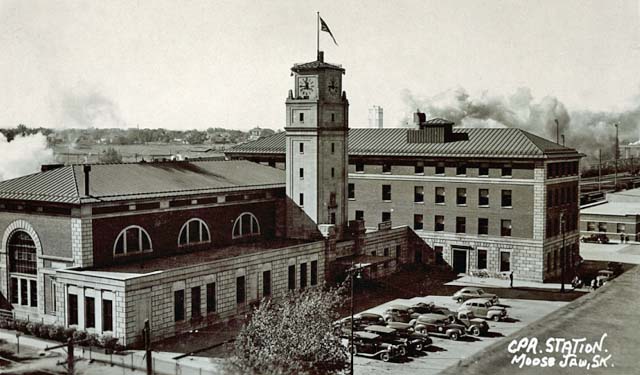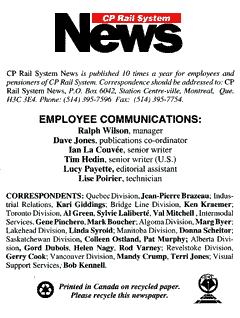
|

|
|
VOL. 25, NO.4
|
MAY 1995
|

in 1922 - Circa 1940 Photographer unknown - Peel Library University of Alberta.
Moose Jaw, Saskatchewan - CP Rail System this year is increasing its presence and activities here, with plans for a $3.7 million track expansion program this summer followed by expanded locomotive maintenance operations at the diesel shop.
In June, the railway will begin to lay a second track alongside its main line for almost five kilometres (three miles), from Moose Jaw east to Pasqua.
Later this year, CPRS also will expand operations at its Moose Jaw diesel shop from minor works to full-scale locomotive maintenance and repairs, increasing the number of employees there to 120 from 73 over the next five years and up to 175 within a decade.
Making the recent announcement, Executive Vice-President Ed Dodge said Moose Jaw quickly is becoming a pivotal hub for the railway, with steep traffic growth on the line east of the city creating a need for a double track to Pasqua.
During the last decade, he said, gross tonnage over the eastbound line has risen to 51 million tonnes (56.1 million tons) a year.
"Moose Jaw is becoming more and more a key transportation node on our railway system. We must react to market changes by adjusting our way of doing business and that means increasing our presence in Saskatchewan. With our investment in increased track capacity, we will relieve train congestion and expedite the national and international movement of commodities such as grain, potash, coal, and containers to centres such as Vancouver, Toronto, Montreal, Chicago, New York, and the U.S. Midwest," Dodge said.
 He attributed much of the
growth to the North American Free Trade Agreement and world market forces that have increased the demand for transportation of bulk commodities and
intermodal traffic.
He attributed much of the
growth to the North American Free Trade Agreement and world market forces that have increased the demand for transportation of bulk commodities and
intermodal traffic.
The double-track program, to be completed by the fall, will provide better gateway access to the U.S., reduce CPRS transit times and cut fuel consumption.
Newly gained efficiencies, including improved traffic flows through Moose Jaw, will help save the railway more than 700 litres (184 gallons) of fuel a day, Dodge said.

